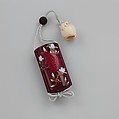Inrō with Cockatoo and Magnolia
Yamada Jōkasai Japanese
Not on view
Inrō are small containers with multiple chambers for holding medicinal herbs, seals, and other small items. They are worn suspended from a sash by means of small toggles that are known as netsuke. Use of inrō, which developed in lieu of pockets in traditional Japanese clothing, flourished from the seventeenth to the nineteenth century. The signature on the bottom of this example reads "Jōkasai," a reference to any one of a number of artists in the Yamada family, active after the late seventeenth century, who used that name.
Due to rights restrictions, this image cannot be enlarged, viewed at full screen, or downloaded.
This artwork is meant to be viewed from right to left. Scroll left to view more.



